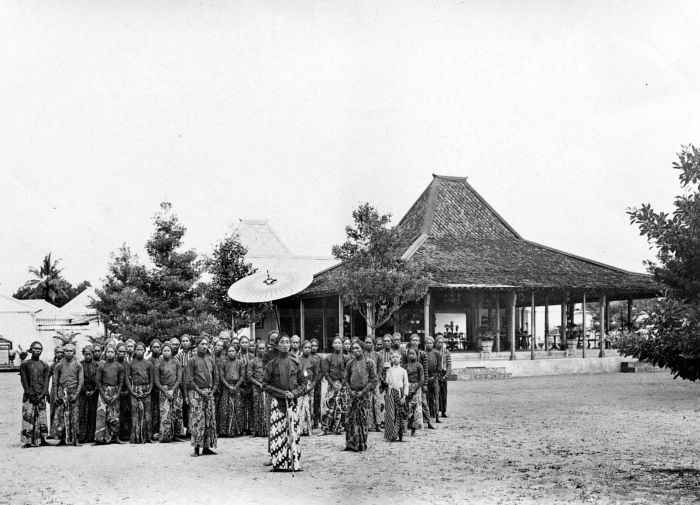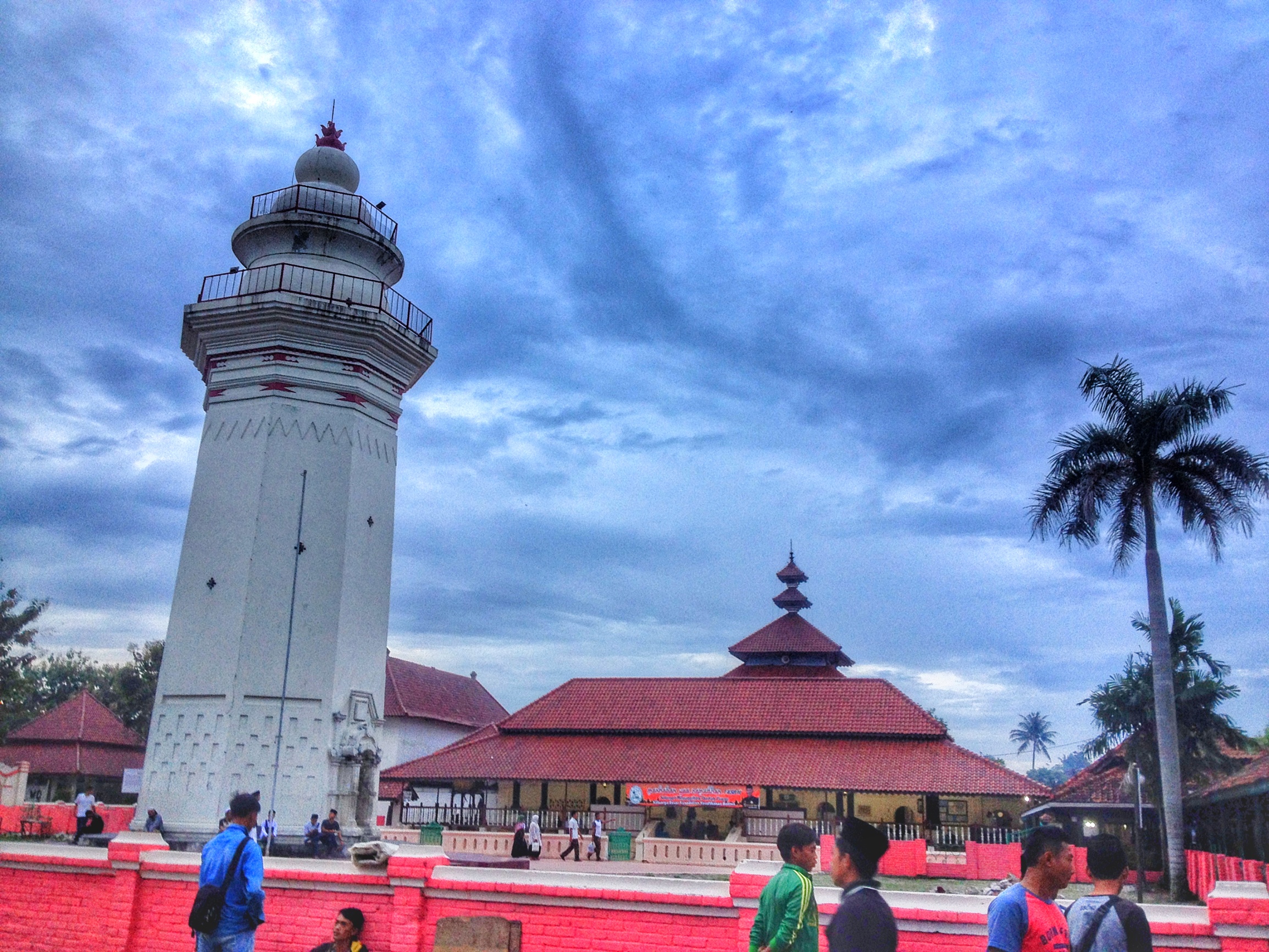|
Great Mosque Of Banten
Great Mosque of Banten ( id, Masjid Agung Banten) is a historic mosque in Old Banten, 10 km north of Serang, Indonesia. The 16th-century mosque was one of the few surviving remnants of what used to be the port city of Banten, the most prosperous trading center in the Indonesian archipelago after the fall of Demak Sultanate in mid-16th century. History The Great Mosque of Banten shows eclectic design, a proof of the international influence in Banten at the time of its construction in 1552. The mosque was constructed in Javanese style during the reign of Sultan Maulana Yusuf, the third Sultan of Banten Sultanate, in Dzulhijjah 966 (1566 CE). A Javanese-styled ''pawestren'' (side hall, used for female's praying hall) was added during the reign of Maulana Muhammad (1580-1586). The southern ''serambi'' (porch) of the mosque was converted into a tomb containing about 15 graves. In 1632, a 24-meter minaret was added to the mosque complex. The minaret was designed by ... [...More Info...] [...Related Items...] OR: [Wikipedia] [Google] [Baidu] |
Old Banten
Old Banten (Indonesian ''Banten Lama'') is an archaeological site in the northern coast of Serang Regency, Banten Province, Banten, Indonesia. Located 11 km north of Serang city, the site of Old Banten contains the ruin of the walled port city of Banten (town), Banten, the 16th-century capital of the Sultanate of Banten. Since 1995, Old Banten has been proposed to UNESCO World Heritage. History Banten was a 16th-century port city known for its pepper. The city flourished when the Islamic Banten Sultanate reached its peak during the 17th century. There was a period of intense conflicts with the Dutch East India Company (VOC) over the trade of spices, which eventually led to the dissolution of the Sultanate in Banten and to the city's decline. Today, the site where the city of Banten remains is known as Old Banten. It is a well-known tourist attraction, where many locals visit to pay their ziarah, respects and pray at the graves of Sultan Maulana Hasanuddin of Banten, Maulana ... [...More Info...] [...Related Items...] OR: [Wikipedia] [Google] [Baidu] |
Joglo
Joglo is a type of traditional vernacular house of the Javanese people (Javanese ''omah''). The word ''joglo'' refers to the shape of the roof. In the highly hierarchical Javanese culture, the type of the roof of a house reflects the social and economic status of the owners of the house; joglo houses is traditionally associated with Javanese aristocrats. Joglo roof can be implemented to a dwelling (''omah'') or a pavilion (''pendopo''). Structure and architecture The joglo roof is the most complex of all Javanese roof types. Different with the other type of Javanese roof such as the limasan and kampung roof, joglo roof does not use king posts. Joglo roof consists of columns that become higher as it go to the center. The four innermost main house columns are often the tallest, while the outer columns are the lowest. These four innermost house columns support a roof that is the steepest of all type of Javanese roof; almost forming a pyramid, except that it comes to two point ... [...More Info...] [...Related Items...] OR: [Wikipedia] [Google] [Baidu] |
Mosques In Indonesia
This is a list of mosques in Indonesia. The Indonesian term ''Masjid Agung'' is translated as "Great Mosque", while ''Masjid Raya'' is translated as "Grand Mosque." ''Masjid Keramat'' is translated as "Holy Mosque." ''Masjid Jami'' is translated as Jami Mosque which refers to the congregational mosque where the weekly Friday prayer takes place. These lists only include notable mosques. List of mosques in Indonesia As of 2020, a government team led by Fakhry Affan has registered 554,152 mosques in Indonesia. This consists of 258,958 congregational mosques and 295,194 small mosques which fit 40 people or fewer. The government estimates total number of mosques at more than 740,000 nationwide.Indonesia's 'mosque hunters' count them up one at a time ''Bang ... [...More Info...] [...Related Items...] OR: [Wikipedia] [Google] [Baidu] |
Religious Buildings And Structures Completed In 1566
Religion is usually defined as a social-cultural system of designated behaviors and practices, morals, beliefs, worldviews, texts, sanctified places, prophecies, ethics, or organizations, that generally relates humanity to supernatural, transcendental, and spiritual elements; however, there is no scholarly consensus over what precisely constitutes a religion. Different religions may or may not contain various elements ranging from the divine, sacred things, faith,Tillich, P. (1957) ''Dynamics of faith''. Harper Perennial; (p. 1). a supernatural being or supernatural beings or "some sort of ultimacy and transcendence that will provide norms and power for the rest of life". Religious practices may include rituals, sermons, commemoration or veneration (of deities or saints), sacrifices, festivals, feasts, trances, initiations, funerary services, matrimonial services, meditation, prayer, music, art, dance, public service, or other aspects of human culture. Religions have sa ... [...More Info...] [...Related Items...] OR: [Wikipedia] [Google] [Baidu] |
Religious Buildings And Structures In Java
Religion is usually defined as a social-cultural system of designated behaviors and practices, morals, beliefs, worldviews, texts, sanctified places, prophecies, ethics, or organizations, that generally relates humanity to supernatural, transcendental, and spiritual elements; however, there is no scholarly consensus over what precisely constitutes a religion. Different religions may or may not contain various elements ranging from the divine, sacred things, faith,Tillich, P. (1957) ''Dynamics of faith''. Harper Perennial; (p. 1). a supernatural being or supernatural beings or "some sort of ultimacy and transcendence that will provide norms and power for the rest of life". Religious practices may include rituals, sermons, commemoration or veneration (of deities or saints), sacrifices, festivals, feasts, trances, initiations, funerary services, matrimonial services, meditation, prayer, music, art, dance, public service, or other aspects of human culture. Religions have sa ... [...More Info...] [...Related Items...] OR: [Wikipedia] [Google] [Baidu] |
Tourist Attractions In Banten
Tourism is travel for pleasure or business; also the theory and practice of touring, the business of attracting, accommodating, and entertaining tourists, and the business of operating tours. The World Tourism Organization defines tourism more generally, in terms which go "beyond the common perception of tourism as being limited to holiday activity only", as people "travelling to and staying in places outside their usual environment for not more than one consecutive year for leisure and not less than 24 hours, business and other purposes". Tourism can be domestic (within the traveller's own country) or international, and international tourism has both incoming and outgoing implications on a country's balance of payments. Tourism numbers declined as a result of a strong economic slowdown (the late-2000s recession) between the second half of 2008 and the end of 2009, and in consequence of the outbreak of the 2009 H1N1 influenza virus, but slowly recovered until the COVID-19 pa ... [...More Info...] [...Related Items...] OR: [Wikipedia] [Google] [Baidu] |
Saka Guru
Saka guru, or soko guru in Javanese, is the four main posts which supported certain Javanese buildings, e.g. the pendopo, the Javanese traditional house, house proper and the List of mosques in Indonesia, mosque. The saka guru is the most fundamental element in Javanese_culture#Architecture, Javanese architecture because it supports the entire roof of the building. Because of its importance, the saka guru is imbued with symbolism and treated with certain rituals. Structure and construction The saka guru construction is employed in buildings that are constructed with a joglo-type or tajug-type (pyramidal) roofs. The joglo type roof is only reserved for the house of the nobles, while the tajug-type roof is used to support sacred buildings e.g. mosques or temples. In Javanese architecture, walls are merely boundaries of room and the exterior with no structural purposes. The main structural columns/posts of a Javanese house (the saka guru) supports directly the roof and not the wall. ... [...More Info...] [...Related Items...] OR: [Wikipedia] [Google] [Baidu] |
List Of Mosques In Indonesia
This is a list of mosques in Indonesia. The Indonesian term ''Masjid Agung'' is translated as "Great Mosque", while ''Masjid Raya'' is translated as "Grand Mosque." ''Masjid Keramat'' is translated as "Holy Mosque." ''Masjid Jami'' is translated as Jami Mosque which refers to the congregational mosque where the weekly Jumu'ah, Friday prayer takes place. These lists only include notable mosques. List of mosques in Indonesia As of 2020, a government team led by Fakhry Affan has registered 554,152 mosques in Indonesia. This consists of 258,958 congregational mosques and 295,194 small mosques which fit 40 people or fewer. The government estimates total number of mosques at more than 740,000 nationwide.Indonesia's 'mosque hunters' count them up one at a time ... [...More Info...] [...Related Items...] OR: [Wikipedia] [Google] [Baidu] |
Tirtayasa
Tirtayasa (1631–1695), complete stylized name Sultan Ageng Tirtayasa, also known as Ageng and Abulfatah Agung, was the sixth sultan of Banten (on Java in modern Indonesia) and reigned during the kingdom's golden age. Overview Ageng built a strong fleet on European models, which did considerable trade within the Indonesian archipelago, and, with help from the English, Danes, and Chinese, were able to trade with Persia, India, Siam, Vietnam, China, the Philippines, and Japan in the Javanese tradition of long-distance traders. This trade gave considerable wealth to Banten, the greatest period for which was arguably under Sultan Ageng Tirtayasa. In 1661 Ageng extended Banten rule to Landak in western Borneo. In the 1670s he also acquired Cirebon area following civil war in Mataram. Ageng established trade with Spanish Manila for silver and built canal for coconut palm and sugar plantations, among other developments. Principal activities Conflict with the Dutch Ageng was a strong ... [...More Info...] [...Related Items...] OR: [Wikipedia] [Google] [Baidu] |
Hasanudin
Maulana Hasanuddin (also spelled Hasanuddin) was a ruler of the Banten Sultanate from c. 1552 to 1570. Hasanuddin was a Azmatkhani Ba 'Alawi Sayyid, the son of Sunan Gunungjati and Nyai Ratu Kawunganten. He extended the domains of Banten to the pepper-producing region of Lampung, in South Sumatra Sumatra is one of the Sunda Islands of western Indonesia. It is the largest island that is fully within Indonesian territory, as well as the sixth-largest island in the world at 473,481 km2 (182,812 mi.2), not including adjacent i .... This area, which already had long-standing ties with West Java, facilitated Banten's rise to prominence as a pepper port.M.C. Ricklefs, ''A History of Modern Indonesia Since c. 1300'', 2nd ed., Stanford: Stanford University Press, 1994, p. 38 Notes Sultans of Banten 16th-century rulers in Asia Pepper trade 1570 deaths Indonesian people of Arab descent {{indonesia-bio-stub ... [...More Info...] [...Related Items...] OR: [Wikipedia] [Google] [Baidu] |
Candi Of Indonesia
A candi () is a Hindu or Buddhist temple in Indonesia, mostly built during the ''Zaman Hindu-Buddha'' or " Hindu-Buddhist period" between circa the 4th and 15th centuries. The ''Kamus Besar Bahasa Indonesia'' defines a ''candi'' as an ancient stone building used for worship, or for storing the ashes of cremated Hindu or Buddhist kings and priests. Indonesian archaeologists describe ''candis'' as sacred structures of Hindu and Buddhist heritage, used for religious rituals and ceremonies in Indonesia. However, ancient secular structures such as gates, urban ruins, pools and bathing places are often called ''candi'' too, while a shrine that specifically serves as a tomb is called a ''cungkup''. In Hindu Balinese architecture, the term ''candi'' refers to a stone or brick structure of single-celled shrine with portico, entrance and stairs, topped with pyramidal roof and located within a ''pura''. It is often modeled after East Javanese temples, and functions as a shrine to a certain ... [...More Info...] [...Related Items...] OR: [Wikipedia] [Google] [Baidu] |








